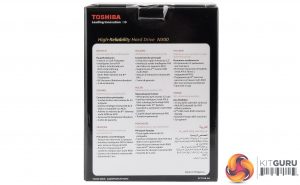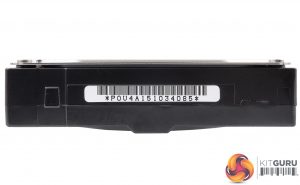
We've already looked at the mainstream P300 and high-end X300 consumer hard drives from Toshiba, now we get the chance to have a look at something a bit more specialised … in the shape of the N300, a drive range specifically designed for use in NAS devices.
The N300 has been designed for use in NAS devices with 1 to 8 drive bays and (at the time of writing) comes in three capacities, 4TB (HDWQ140XZSTA), 6TB (HDWN160XZSTA) and the flagship 8TB (HDWN180XZSTA) which Toshiba supplied for review. The 8TB model is currently Toshiba's largest capacity hard drive.
The N300 drives have 7,200rpm spindle speeds and have a cache of 128MB. The quoted sustained transfer speed for the 8TB drive is 240MB/s with an average latency of 4.17ms. Toshiba also quote a workload figure for the drive of 180TB/year with 24×7 operation and back the drive with a 3-year warranty.
Physical Specifications:
Usable Capacities: 4TB, 6TB, 8TB.
Spindle Speed: 7,200rpm.
No. Of Heads: 12
No. Of Platters: 6
Cache: 128MB
Recording Method: Perpendicular
Interface: Serial ATA (SATA) 6Gb/s (SATA III)
Form Factor: 3.5in
Dimensions: 147 x 101 x 26mm
Drive Weight: 770g
Firmware Version: GX2M
The Toshiba N300 uses the same box styling as both the P300 and the X300 with an image of an open drive on the front together with good clear descriptions of its capacity, spin speed, cache and usage. The back of the box has a panel of multilingual statements of the drive’s features.
Built on a standard 3.5in format, the 8TB N300 uses six 1.33TB platters (discs) with twelve read/write heads. The drive features several technologies designed to increase reliability in a multi-disk environment.
The N300 series feature a 128MB cache and uses Toshiba’s Dynamic Cache Technology to optimise cache allocation during read/writes to maintain high performance. The drives also have Toshiba Stable Platter technology which helps minimise the effects of system vibration by the use of a tied spindle motor which secures the motor drive shaft at both ends.
Also helping the fight against vibration are built in sensors which detect shock and rotational vibration and compensate for both. RV (rotational vibration) may not seem much of a problem when you only have a couple of drives in the same enclosure but when there are six or more drives in the same box it can become a real issue.

A quick look at the underside of the PCB reveals a Marvell 88i1017-NBD2 storage controller, a Winbond DDR2-800 DRAM chip and a spindle controller coded 601NCCGC.
For testing, the drives are all wiped and reset to factory settings by HDDerase V4. We try to use free or easily available programs and some real world testing so you can compare our findings against your own system.
This is a good way to measure potential upgrade benefits.
Main system:
Intel Core i7 4790K with 16GB of DDR3-2133 RAM, Sapphire R9 390 Nitro and an ASRock Extreme 6 motherboard.
Other drives:
Seagate NAS 8TB
Seagate IronWolf 10TB
Toshiba P300 3TB
Toshiba X300 6TB
WD Black 6TB
WD Black 4TB
WD Red 4TB
WD Red 8TB
Software:
Atto Disk Benchmark.
CrystalMark 3.0.3.
IOMeter
All our results were achieved by running each test five times with every configuration this ensures that any glitches are removed from the results.
Crystalmark is a useful benchmark to measure theoretical performance levels of hard drives and SSD’s. We are using V3.0.3.

The Toshiba N300's read performance (when it comes to small bity files at a deepish queue depth) is better than both Toshiba's X300 and P300 drives. However, it falls in between both of them in terms of write performance – being much faster than the P300 but not quite as quick as the X300.
The ATTO Disk Benchmark performance measurement tool is compatible with Microsoft Windows. Measure your storage systems performance with various transfer sizes and test lengths for reads and writes. Several options are available to customize your performance measurement including queue depth, overlapped I/O and even a comparison mode with the option to run continuously.
Use ATTO Disk Benchmark to test any manufacturers RAID controllers, storage controllers, host adapters, hard drives and SSD drives and notice that ATTO products will consistently provide the highest level of performance to your storage.


Toshiba quote a sustained transfer rate for the 8TB drive at 240MB/s, something that was confirmed by the ATTO benchmark. The tested drive produced a read rate of 246MB/s with writes at 244MB/s. Both rates are significantly faster than the other two Toshiba drives we've recently looked at and faster than the other two 8TB drives on the list, the WD Red and the Seagate NAS.
IOMeter is another open source synthetic benchmarking tool which is able to simulate the various loads placed on hard drive and solid state drive technology.
We test with both random read and write 4k tests, as shown above.


When it comes to the 4K random read/write IOPS performance of the drive, the N300 sits between its two siblings in terms of write performance but its a different story when it comes to reads as the N300 is faster than the P300 and the X300.
To test real life performance of a drive we use a mix of folder/file types and by using the FastCopy utility (which gives a time as well as MB/s result) we record the performance of the drive reading from & writing to a 256GB Samsung SSD850 PRO.
60GB Steam folder – 29,521 files.
50GB File folder – 28,523 files.
12GB Movie folder – 24 files (mix of Blu-ray and 4K files).
10GB Photo folder – 621 files (mix of .png, raw and .jpeg images).
10GB Audio folder – 1,483 files (mix of mp3 and .flac files).

The N300 dealt with the real life file transfers very well. The 60GB Steam folder and in particular the 50GB file folder transfers are ones that quite often cause problems in terms of slowing a drive down but the N300 had no problems dealing with them. The 50GB folder took a shade under 3 minutes to write to the drive and just over 3 minutes to read the data back.
WD and Seagate have had NAS-ready hard drives in the market place for quite some time – WD with the Red and Red Pro series and Seagate with the NAS, IronWolf and IronWolf Pro drives so it will be interesting to see how much of an inroad into the market Toshiba can make with the N300.

The N300 8TB drive is a 6 platter (disc) design and six platters in a standard 3.5in enclosure is about as far as current hard drive technology will allow without the benefit of Helium technology. Because Helium has 1/7 the density of air it produces a lot less turbulence inside the drive housing, reducing disc resistance which in turn means less power to drive the discs and a reduction in heat production.
As Helium causes less disc flutter, the platters themselves can be made thinner, so more of them can be stacked inside the drive casing, leading to larger capacity drives.
Having lots of hard drives inside a single enclosure can lead to problems due to vibration and Toshiba have equipped the N300 with technologies to try and counteract any potential problems. Multiple sensors inside the drive monitor, detect and compensate for RV (Rotational Vibration) and other forms of shock that the drive might encounter. Toshiba's Stable Platter technology utilises a tied spindle motor to stabilise the motor drive shaft at both ends to protect against system-induced vibration, while Toshiba’s Ramp Load technology reduces disk head wear and tear.
Toshiba quote a sustained transfer rate for the 8TB N300 at 240MB/s, something we were able to confirm with the ATTO benchmark, the reviewed disk producing figures of 246MB/s for reads and 244MB/s for writes.
The official power figures for the 8TB N300 are 9.2W typical when in operation, less power than both the 4TB and 6TB models and 6.2W when in active idle, which is better than the 6TB drive (6.7W typical) but not as frugal as the 4TB drive (5.2W) typical.
We found the Toshiba N300 8TB for sale on LambdaTek for £282.53 (inc VAT) HERE
Discuss on our Facebook page HERE.
Pros
- Fast performance.
- Technologies to aid reliability in a NAS environment.
Cons
- Not as energy efficient as some of its 8TB competitors.
Kitguru says: Toshiba's N300 might be a late arrival into the NAS drive market but it's a fast performing drive packed with features to help it survive in a multi-disk environment.
 KitGuru KitGuru.net – Tech News | Hardware News | Hardware Reviews | IOS | Mobile | Gaming | Graphics Cards
KitGuru KitGuru.net – Tech News | Hardware News | Hardware Reviews | IOS | Mobile | Gaming | Graphics Cards















Nice…